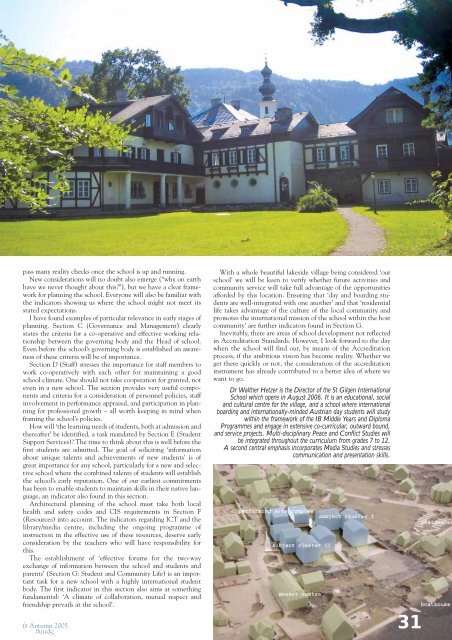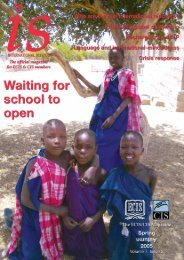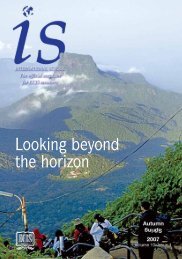is magazine 8.1 - Autumn/Spring 2005 - International Schools ...
is magazine 8.1 - Autumn/Spring 2005 - International Schools ...
is magazine 8.1 - Autumn/Spring 2005 - International Schools ...
You also want an ePaper? Increase the reach of your titles
YUMPU automatically turns print PDFs into web optimized ePapers that Google loves.
pass many reality checks once the school <strong>is</strong> up and running.<br />
New considerations will no doubt also emerge (“why on earth<br />
have we never thought about th<strong>is</strong>?”), but we have a clear framework<br />
for planning the school. Everyone will also be familiar with<br />
the indicators showing us where the school might not meet its<br />
stated expectations.<br />
I have found examples of particular relevance in early stages of<br />
planning. Section C (Governance and Management) clearly<br />
states the criteria for a co-operative and effective working relationship<br />
between the governing body and the Head of school.<br />
Even before the school’s governing body <strong>is</strong> establ<strong>is</strong>hed an awareness<br />
of these criteria will be of importance.<br />
Section D (Staff) stresses the importance for staff members to<br />
work co-operatively with each other for maintaining a good<br />
school climate. One should not take cooperation for granted, not<br />
even in a new school. The section provides very useful components<br />
and criteria for a consideration of personnel policies, staff<br />
involvement in performance appra<strong>is</strong>al, and participation in planning<br />
for professional growth – all worth keeping in mind when<br />
framing the school’s policies.<br />
How will ‘the learning needs of students, both at adm<strong>is</strong>sion and<br />
thereafter’ be identified, a task mandated by Section E (Student<br />
Support Services)? The time to think about th<strong>is</strong> <strong>is</strong> well before the<br />
first students are admitted. The goal of soliciting ‘information<br />
about unique talents and achievements of new students’ <strong>is</strong> of<br />
great importance for any school, particularly for a new and selective<br />
school where the combined talents of students will establ<strong>is</strong>h<br />
the school’s early reputation. One of our earliest commitments<br />
has been to enable students to maintain skills in their native language,<br />
an indicator also found in th<strong>is</strong> section.<br />
Architectural planning of the school must take both local<br />
health and safety codes and CIS requirements in Section F<br />
(Resources) into account. The indicators regarding ICT and the<br />
library/media centre, including the ongoing programme of<br />
instruction in the effective use of these resources, deserve early<br />
consideration by the teachers who will have responsibility for<br />
th<strong>is</strong>.<br />
The establ<strong>is</strong>hment of ‘effective forums for the two-way<br />
exchange of information between the school and students and<br />
parents’ (Section G: Student and Community Life) <strong>is</strong> an important<br />
task for a new school with a highly international student<br />
body. The first indicator in th<strong>is</strong> section also aims at something<br />
fundamental: ‘A climate of collaboration, mutual respect and<br />
friendship prevails at the school’.<br />
<strong>is</strong> <strong>Autumn</strong> <strong>2005</strong><br />
<strong>Spring</strong><br />
With a whole beautiful lakeside village being considered ‘our<br />
school’ we will be keen to verify whether future activities and<br />
community service will take full advantage of the opportunities<br />
afforded by th<strong>is</strong> location. Ensuring that ‘day and boarding students<br />
are well-integrated with one another’ and that ‘residential<br />
life takes advantage of the culture of the local community and<br />
promotes the international m<strong>is</strong>sion of the school within the host<br />
community’ are further indicators found in Section G.<br />
Inevitably, there are areas of school development not reflected<br />
in Accreditation Standards. However, I look forward to the day<br />
when the school will find out, by means of the Accreditation<br />
process, if the ambitious v<strong>is</strong>ion has become reality. Whether we<br />
get there quickly or not, the consideration of the accreditation<br />
instrument has already contributed to a better idea of where we<br />
want to go.<br />
Dr Walther Hetzer <strong>is</strong> the Director of the St Gilgen <strong>International</strong><br />
School which opens in August 2006. It <strong>is</strong> an educational, social<br />
and cultural centre for the village, and a school where international<br />
boarding and internationally-minded Austrian day students will study<br />
within the framework of the IB Middle Years and Diploma<br />
Programmes and engage in extensive co-curricular, outward bound,<br />
and service projects. Multi-d<strong>is</strong>ciplinary Peace and Conflict Studies will<br />
be integrated throughout the curriculum from grades 7 to 12.<br />
A second central emphas<strong>is</strong> incorporates Media Studies and stresses<br />
communication and presentation skills.<br />
31




